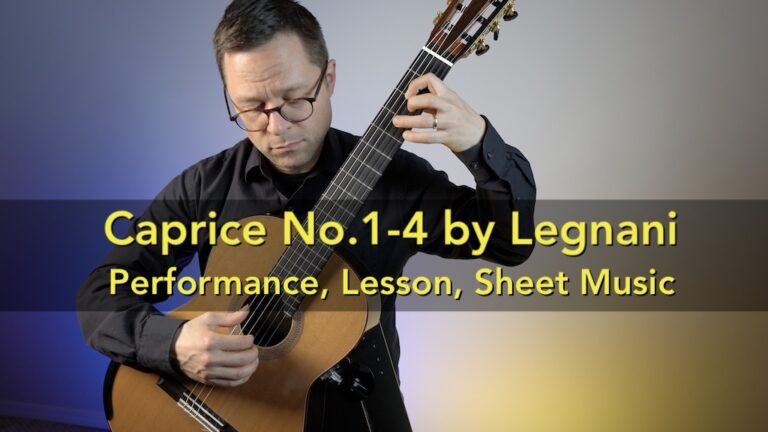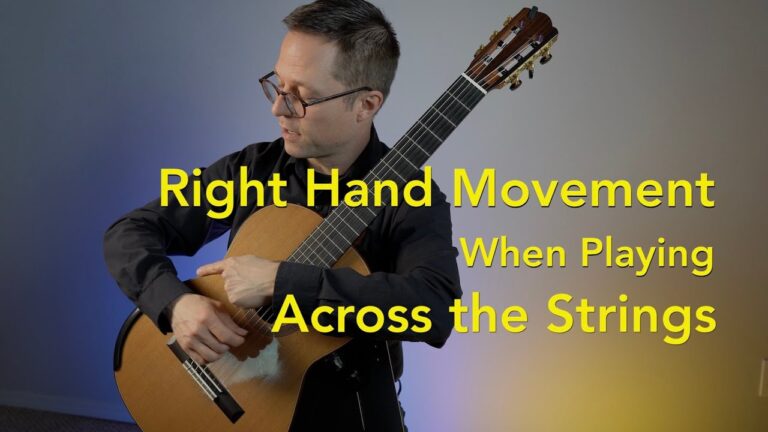This lesson comes from my book Classical Guitar Repertoire Lessons Grade 4 – Six pieces at the grade four level with dedicated lessons preparing you for each piece.
Rondo, Op.241, No.34 by Ferdinando Carulli (1770-1841) – YouTube Video Lesson Link. Although there are no new techniques or musical elements to learn in this Rondo by Carulli, the level of activity in both hands is much higher than any piece encountered in my books so far. A rondo is a form of music where a theme is repeated throughout the work with contrasting sections intervening. I’ve marked the sections on the score with rehearsal marks: A, B, C, D, and E. The theme, A section, appears three times. The Form, or section order, is: A – B – C – A – D – E – A
Recognizing Scales & Arpeggios – It’s important to recognize the type of musical texture you’re playing so you can either sustain notes as chords or chose to play a melodic single line. Remember, all the textures may contain melody so continue to phrase accordingly.
- During scales or melodic material, play a single line as legato as possible.
- During arpeggios, leave your fingers down to sustain all the notes as full chords (some upper notes are melody).
- Mixed passages may combine both textures, so you might have an arpeggio with passing non-chord tones (notes that are not part of the chord).





Hi Bradford, I´ve recently taken on this piece and like it more and more, the more I practice it. I have a question about the very last G chord; it´s written with all 6 notes but if I understand it correctly it´s only the base G and the three top notes GBG that are actually played? If so, why are the base B and D notes written out at all ?
Good question. You play all six notes, i-m-a play the top notes and the thumb can sweep over the three bass notes. Alternatively, you can strum the whole chord with your thumb if you prefer. If either of these options don’t work (at the moment) you can just play the low G and leave out the other bass notes while you work on the technique.
Hi Bradford. Lovely piece, lovely playing, great lesson. I have come back to this lesson after having worked on it some months ago. At that time I wasn’t as concerned about muting notes so as not to bleed into a new phrase. I have been working on that as I review all my previous repertoire attempts. So I have a question about a section of the rondo starting in the 2nd half of measure 2. Should the open G (3rd string) ending the arpeggio be muted? If I let this ring, it seems to muddy the following scale passage. I’m trying to mute this with my thumb but wondering if you have other suggestions. It sounds (to my ears) like you are not letting this ring but I can’t quite figure it out. Thanks!
Just let the G ring, I don’t think it’s noticeable. Plus it should be soft to begin with since it is accompaniment. Also, considering the activity in the upper voice I don’t think anyone would mute the G in this situation. The bass mute is plenty to clean up the texture.
Love classical guitar. I have a Baritone Uke. that is tuned to EBGD and and wondering if this music can be adapted to playing since I am missing the bottom A and E strings. It is not easy to find music and I love classical and don’t just want to play chords. I am playing easy guitar classical already but need better music to play. I know my notes and am working on chords. I play Mandolin in Mandolin Orchestra and am familier with note reading and lots of Theory. Love the Carulli you are playing.